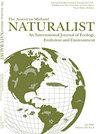猪笼草(Sarracenia purpurea)对其Inquiline食物网结构的调控
IF 0.6
4区 环境科学与生态学
Q4 Agricultural and Biological Sciences
引用次数: 5
摘要
摘要在猪笼草、凤梨树和树洞等充满水的栖息地中,植物网是多营养食物网的宿主,是研究食物网结构和动态的模型实验系统。然而,植物通常被认为只是一个惰性容器,而不是食物网的一个相互作用的部分。我们采用响应面设计的操纵田间实验,以确定营养富集(不同水平的NH4NO3、PO4和捕获的猎物)、顶部捕食者(去除或存在)和植物本身(有或没有插入塑料管以将食物网与植物隔离)对肉食性猪笼草(Sarracenia purpurea)改良叶片(“猪笼草”)内的大型食物网的影响。与植物的连接、NH4NO3的添加和顶级捕食者的移除显著增加了食物网的饱和度,定义为其营养深度和相互作用的数量。添加PO4或补充猎物对食物网饱和度无影响。像s.p ulpurea这样的植物,产生植骨瘤不仅仅是惰性容器,它们的居民也不仅仅是共生的昆虫。更确切地说,植物和inquilines都是一个复杂的互动网络中的伙伴。本文章由计算机程序翻译,如有差异,请以英文原文为准。
Regulation by the Pitcher Plant Sarracenia purpurea of the Structure of its Inquiline Food Web
Abstract. Phytotelmata, the water-filled habitats in pitcher plants, bromeliad tanks, and tree-holes, host multitrophic food webs that are model experimental systems for studying food-web structure and dynamics. However, the plant usually is considered simply as an inert container, not as an interacting part of the food web. We used a manipulative field experiment with a response-surface design to determine effects of nutrient enrichment (multiple levels of NH4NO3, PO4, and captured prey), top predators (removed or present), and the plant itself (with or without plastic tubes inserted into the pitchers to isolate the food web from the plant) on the macrobial food web within the modified leaves (“pitchers”) of the carnivorous pitcher plant Sarracenia purpurea. Connection to the plant, addition of NH4NO3, and removal of the top predator significantly increased the food web's saturation, defined as its trophic depth and number of interactions. No effects on food-web saturation resulted from addition of PO4 or supplemental prey. Plants such as S. purpurea that create phytotelmata are more than inert containers and their inhabitants are more than commensal inquilines. Rather, both the plant and the inquilines are partners in a complex network of interactions.
求助全文
通过发布文献求助,成功后即可免费获取论文全文。
去求助
来源期刊

American Midland Naturalist
环境科学-生态学
CiteScore
1.20
自引率
0.00%
发文量
38
审稿时长
18-36 weeks
期刊介绍:
The American Midland Naturalist has been published for 90 years by the University of Notre Dame. The connotations of Midland and Naturalist have broadened and its geographic coverage now includes North America with occasional articles from other continents. The old image of naturalist has changed and the journal publishes what Charles Elton aptly termed "scientific natural history" including field and experimental biology. Its significance and breadth of coverage are evident in that the American Midland Naturalist is among the most frequently cited journals in publications on ecology, mammalogy, herpetology, ornithology, ichthyology, parasitology, aquatic and invertebrate biology and other biological disciplines.
 求助内容:
求助内容: 应助结果提醒方式:
应助结果提醒方式:


